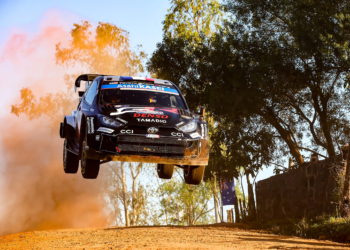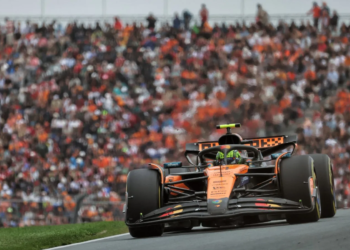So it happened after all. For a time the 2019 Japanese Grand Prix looked under threat from Typhoon Hagibis, to the point that on Saturday its host Suzuka circuit was close to a no-go area. But come Sunday’s race day the clouds parted both metaphorically and literally, and as scheduled we had a race. As in Formula 1 we always seem to.
And this point is backed by fact as well as perception. Plenty of scheduled F1 meetings have been cancelled in advance of course, but it may come as a surprise that never once in the F1 world championship’s entire existence stretching all the way to 1950 has a race been ditched after a meeting has got going. Despite F1’s notorious modern-day risk aversion. Despite too its regular capacity for politicking and dispute.
And of course there is nothing inevitable about motor races going ahead. MotoGP for one, where men are men we are told, cancelled a race mid-meeting as recently as last season.
As we often are given cause to comment, F1 is a branch of show business. So is F1’s ubiquitous record a demonstration of the number one rule of show business that the show must go on? Perhaps not – it seems more of the explanation is dumb luck.
Joe Saward noted over the Suzuka weekend that this is the third time in recent times F1 has had the fortune that a Japanese typhoon has hit the Saturday and not Sunday, therefore impacting qualifying and not the race. Adding further to these cases, rain also led to qualifying disruption in Australia in 2013 and Austin in 2015, and the races went ahead just fine.
One of these days insurmountable weather will land on Sunday instead, at which point there will be hell to pay.
In America, where oval racing for one can’t happen on a wet track, it’s common in such circumstances simply to shift the race to the Monday. But F1 doesn’t have that get-out either. “F1 is way too big and infinitely organised to simply delay the event a day,” Saward noted. “Freight has to be on the move and chartered planes have to be ordered months ahead. So one day it is all going to go wrong…”
It may come as a surprise that never once in the F1 world championship’s entire existence stretching all the way to 1950 has a race been ditched after a meeting has got going.
As noted, it’s not happened yet. But in any case F1’s past is rarely all that simple, and it isn’t here. There are indeed a few cases where a F1 grand prix has been ‘sort of’ cancelled.
I’m sure were the late FIA president Jean-Marie Balestre among us he’d be arguing that the 1980 Spanish Grand Prix technically didn’t happen. A race did happen, and with most of the F1 cars and drivers, but it was not one under FIA sanction. Then there’s Indianapolis in 2005 which was barely a race. Dallas in 1984 was a notorious near miss. The shortest F1 race was the 1991 Australian Grand Prix, rained off after just 14 laps.
Then there is the most conspicuous case. When the race did happen, but several months after the first day of practice. This was the Belgian Grand Prix in 1985 at Spa-Francorchamps. It took place on September 15 and Ayrton Senna won it in fine style. But it was supposed to happen on June 2.
Then in balmy early summer all had gathered at the popular circuit in good heart. And on Friday morning a hand-out, from Belgian road surface specialist firm HYDROCAR, was put under various noses.
The hand-out’s opening paragraph read: “In order to reinforce the safety of the road racing set in Francorchamps for pilots by eliminating the AQUAPLANING and increasing the roughness and the adherence of pneumatic tyres, giving by consequence to this marvellous road racing set the ‘ALL WEATHERS’ label, the circuit for its entire length of 6,945 metres has been covered by a RUBBERISED ASPHALT open graded friction course on a SAMI (Stress Absorbing Membrane Interlayer).”
The redoubtable Denis Jenkinson took up the story. “I think what they were trying to tell us was that the new demon surface that had been put down was going to give much more grip and in the wet it was going to be far superior to anything yet tried, all of which was most laudable,” Jenks explained. It was especially laudable at Spa where rain of course is a common feature.
“What they didn’t tell us,” Jenks continued, “was that they had only finished the resurfacing a bare 14 days before practice was due to begin.”
There is the most conspicuous case. The race did happen, but several months after the first day of practice. This was the Belgian Grand Prix in 1985. It took place on September 15. But it was supposed to happen on June 2.
Quite. The Belgian authorities had asked FISA (as FIA’s sporting arm was then known) the previous October if it could resurface the Spa track. FISA said yes, so long as the work was done at least 60 days before the grand prix. But then cumbersome decision making and a harsh winter delayed things, and the work didn’t even begin until within a month of the race date.
At around this point too a scheduled Spa test was cancelled due to circuit ‘modifications’. This might have set off FISA’s alarm bells or at least its curiosity. But it didn’t. Instead, FISA arrived at the track the night before the grand prix’s first practice to express horror and surprise at the work’s late completion.
But even so all were on course to just about get away with it. During the first day of running on Friday the track did indeed struggle to hold together amid the fat grippy tyres and raucous turbo power. Plus, irony of ironies, the weather was hot and sunny all weekend – almost unheard of at Spa – and this didn’t help matters.
Yet even so Friday’s running happened with little untoward, beyond Nigel Mansell picking up a puncture and Nelson Piquet a cracked visor. Drivers indeed were favourable initially to the new surface; it offered impressive grip as demonstrated by low lap times.
There were though particular trouble spots of the surface breaking up at three corners in the track’s middle section that would require some work, but drivers were happy to adapt lines to suit. Plus Spa’s opening and closing sections were then made up of public roads and the resultant road traffic had been successful in compacting the new asphalt there.
No, the trouble really kicked in when track ‘repairs’ were then attempted overnight. This rapidly became obvious when F1 cars headed back out on the Saturday. “It did not take long to realise that something strange was happening,” Jenks noted, “for lap times were down below 2min 20sec, nearly 25 seconds slower than the day before.
“After just over half-an-hour of running everyone drew into the pitlane and practice stopped. The drivers had found that the contractors had not only resurfaced the parts that were breaking up on Friday evening, but had continued the resurfacing the full width of the road.
“As the surface had deteriorated on Friday the drivers had changed their lines slightly and gone wide of the bad bits, and were quite prepared to do the same on Saturday morning, keeping off the repaired surface, but with the new asphalt right across the track there was nowhere to go accept across it and there wasn’t a snowball’s chance in hell of the new tarmac having set properly.
“In addition the well-meaning contractors had also resurfaced three more corners that did not need doing, so whereas on Friday evening it had been ‘possible’ to drive the circuit at racing speeds, it was now ‘impossible’ and if you cannot go at racing speeds in a Formula 1 car there really isn’t any point in being in one.”
It did not take long to realise that something strange was happening, for lap times were down below 2min 20sec, nearly 25 seconds slower than the day before – Denis Jenkinson
One indeed could remove lumps from the track with their heel and bare hands. There looked no way a race could take place, but as seems the insistent nature of these things there was no immediate decision. Discussions continued for much of the rest of the day. Deadlines and inspections came and went. Little work was done to the track beyond brushing. The silence was broken but briefly by Renault Alpine GT cars being allowed out for a short spell.
Oddly though at 5:50pm that day an announcement was made, in English and French, that the race day’s schedule the next day would happen as planned after all. The press dutifully reported as much plus the spectators, who’d hung around all day with little to look at, filed out consoled that there would at least be a race.
“That announcement amounted to deceit,” said Maurice Hamilton in Autocourse. “The organisers knew that discussions were continuing.” What’s more the discussions looked headed for an inevitable conclusion.
The drivers, with Niki Lauda prominent, were resolute that the track was unsuitable and, amid more promises of overnight ‘repairs’, were keen for a final decision to be made that day. They knew from the previous year at Dallas that if they left the matter open until race day the pressure to race come what may would be too great.
And Balestre, reached by telephone, agreed with the drivers. At 7:45pm on Saturday it was confirmed that they were calling the thing off.
That wasn’t the end of the story though. Come Sunday the track had an eerie feel on what should have been race day, but the fraternity for Formula 3000 – the Formula 2 of its day – had been lingering the whole while. It was there as a support event, indeed it was supposed to race on the Saturday. And after more track repairs it was, against expectations, called upon to race on Sunday.
The official explanation was that F3000 had a different set of stewards to F1, but judging by what came next it was more likely a meagre sop to television as well as to the spectators who had turned up having been foolish enough to believe the organisers’ announcement from the previous day.
The race was little endorsement of the surface, as no fewer than 11 cars spun off and only by luck was no-one badly hurt.
For this whole shambles, the Belgian organisers only were fined $10,000 and as noted quickly got another go at hosting the race a few months later. Though in a final reverberation Alan Jones for Haas Lola, which had debuted amid fanfare in the previous round at Monza, could not take part as it hadn’t been on the original event’s entry list!
And F1, quite literally, has never seen the like of that weekend again.







Discussion about this post